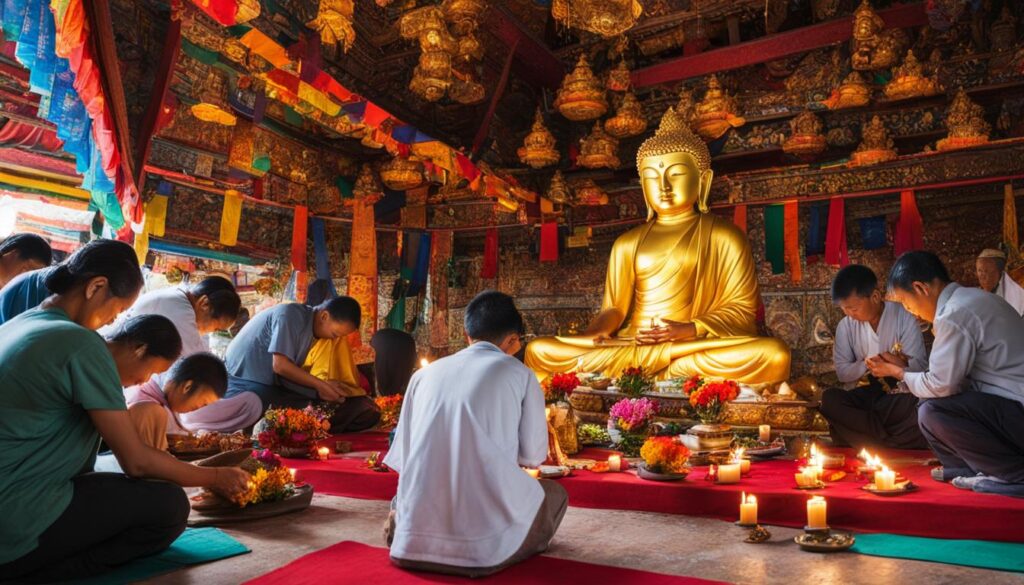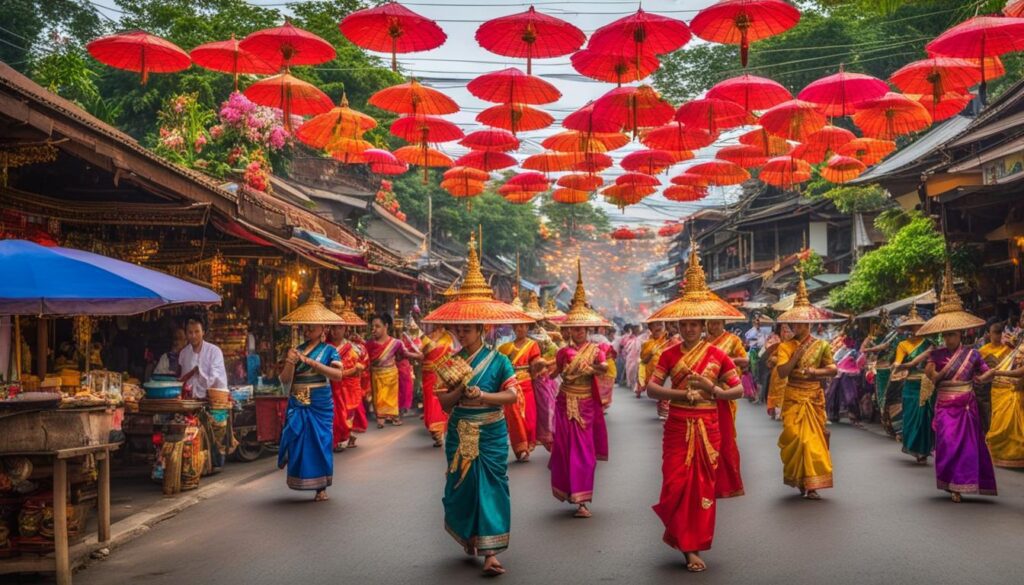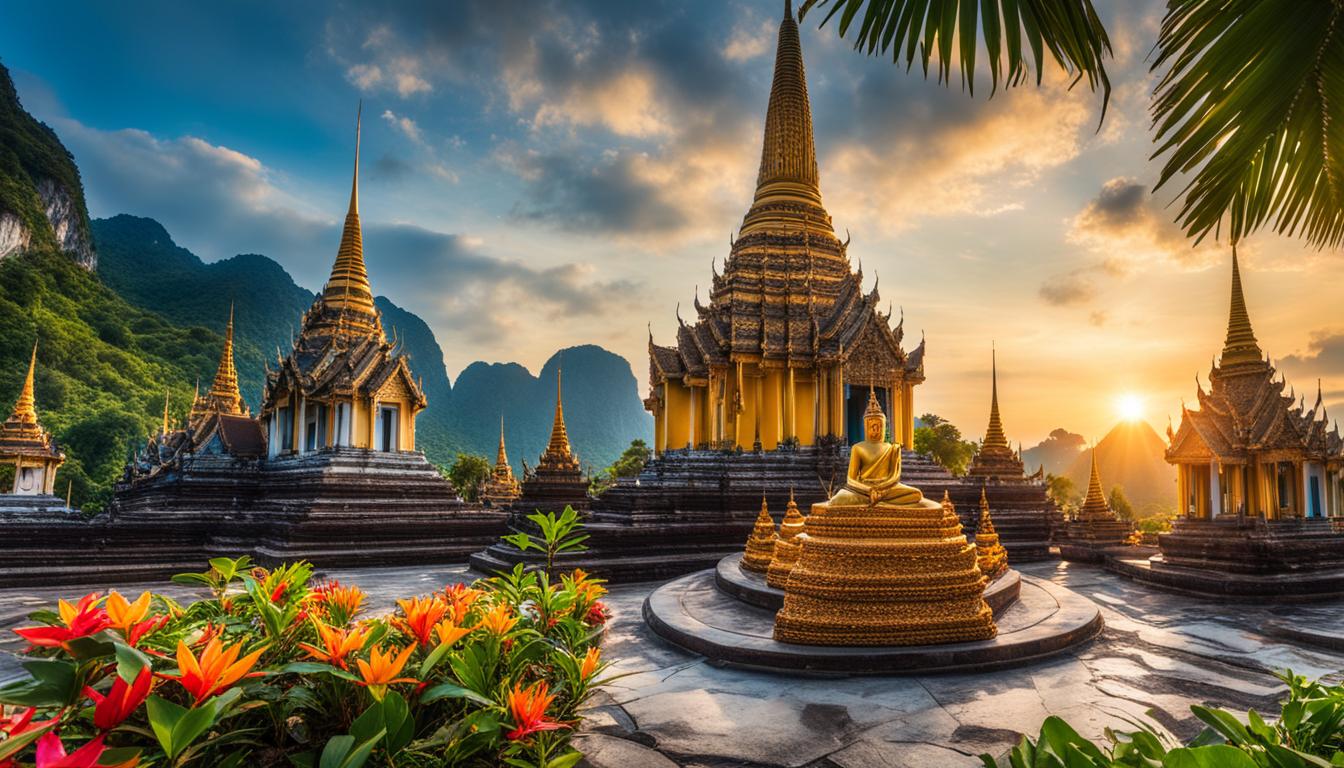Discover the essential Thailand tips to elevate your trip. Learn important things to know about Thailand, from culture to cuisine & beyond!
Did you know that Thailand hails as one of the only Southeast Asian countries never to have been colonized by European powers? This singular fact has cultivated a richly authentic Thai culture and an unparalleled tourism experience. Whether it’s the serenity of Thai beaches, the vibrancy of Bangkok attractions, or the elegance of Thai cuisine, the Land of Smiles is an enchanting world teeming with unique tourist attractions. For those planning a visit, this comprehensive Thailand travel guide peels back the layers of Thailand travel tips, covering everything from Thai customs to Thailand visa requirements, ensuring your odyssey through this cultural tapestry is as smooth as the silk for which it’s famed.
With the wisdom eked from more than two decades of travels, say goodbye to the tourist faux pas and hello to insightful encounters. Intricate details on navigating the nuances of Thai culture, indulging in the culinary maze of Thai street food, and smart tips for getting around will enrich your experience; they’re not just travel tips for Thailand, they’re your keys to the kingdom. So before you jump into your adventure, let’s ensure you’re equipped with the knowledge to fully enjoy the lush landscapes, delectable dishes, and warm hospitality of this storied Southeast Asian nation.
Key Takeaways
- Embrace the depth of Thai culture and the intricacies of Thai customs for a heartfelt welcome.
- Indulge responsibly in Thai cuisine, from sizzling street food to opulent eateries.
- Understand Thailand visa requirements to avoid any travel hitches en route to paradise.
- Visit renowned Bangkok attractions and hidden gems across the country with proper planning.
- Respect the etiquette surrounding tourist attractions in Thailand for an enriching visit.
- Leverage these essential Thailand travel tips to craft the ultimate itinerary.
- Dip your toes in the picture-perfect Thai beaches and let the adventure begin.
Navigating Thailand Visa Requirements
Understanding the Thailand visa requirements is essential for any traveler contemplating a visit to this Southeast Asian paradise. Whether it’s a brief sojourn or an extended getaway, the rules are clear—foreign visitors must adhere to the Thai visa policy for a smooth experience upon arrival. A passport with a minimum of six months validity is a non-negotiable criterion for entry.
Visitors from many Western nations are granted a 30-day stamp on arrival, simplifying the process for tourists. Similarly, those entering Thailand via land now benefit from this duration of stay as part of a policy update. It’s crucial to be aware that overstaying your welcome can result in fines and, although not recommended, occurs with enough frequency to be a point of concern.
For those seeking to extend their immersion in the vibrant Thai culture and customs, Thai immigration offices found in major cities such as Bangkok and Chiang Mai, offer visa runs and extension services. This routine process is a well-trodden path for visitors looking to lengthen their stay.
Looking to explore Thailand beyond the ordinary? Consider applying for an e-visa for Thailand prior to your departure. This electronic convenience allows travelers to procure a longer visa, extending their experiences in this diverse nation for up to two months. Dive into the depths of Thailand’s rich culture, visit lush countryside, and bask on pristine beaches— all while knowing your visa aligns with legal requirements.
Here’s a quick guide to assist you with the visa process:
- Check passport validity: Ensure your passport is valid for at least six months beyond your planned date of entry.
- Visa on Arrival: Most Western tourists can benefit from this entry perk for stays up to 30 days.
- Visa Extensions: Need more time? Visit a Thai immigration office to extend your stay.
- Overland Entry: Same 30-day rule now applies for those entering through land borders as well.
- Electronic Visas: Plan ahead and apply for an e-visa if a longer stay is in your cards.
- Avoid Overstays: Stick to the rules and avoid fines by respecting the duration of your visa.
As enticing as it can be to lose oneself in the marvels of Thailand, a responsible traveler will always ensure they stay within the provisions set by the country’s visa policies. Respect for these regulations reflects a deeper appreciation for Thai culture and customs, fostering a more enriching and hassle-free adventure.
Deciding the Best Time to Visit Thailand
When planning a trip to Thailand, timing plays a crucial role in the overall experience. From soaking up the sun on the pristine beaches to exploring Thailand’s historical sites, choosing the right season can make all the difference. Whether you’re joining in the vibrant Thai festivals, or seeking the perfect snapshot of Thailand’s landscapes, we’ve broken down the essentials of Thailand’s weather and climate to help you select the best time for your visit.
Understanding Thailand’s Seasons
The Thai calendar is typically divided into three distinct seasons: hot, rainy, and cool. Each brings its own set of characteristics that can influence your travel plans. The hot season, running from March to June, sees higher temperatures and minimal rainfall, making it ideal for beach-goers. Transitioning into the rainy season from July to October, travelers can expect brief yet heavy downpours, often providing respite from the heat. The cool season, which spans from November to February, offers a comfortable climate, conducive to exploring outdoor attractions.
Rainy Season Advisories
Thailand weather during the rainy season doesn’t necessarily mean non-stop rain. Instead, it usually involves periodic showers that can bring cooler temperatures, nutritive bouts to the countryside, and a refreshing atmosphere to the urban settings. It is, however, advisable to be prepared for surprise showers, so packing a waterproof jacket or a sturdy umbrella is recommended. The rainfall can also enhance the beauty of Thailand’s natural landscapes, making it a great time for photographers and nature lovers.
Peak Travel Periods
The peak travel periods in Thailand tend to occur during the cool and dry months, particularly between December and April. This is when Thailand’s weather and climate are most favorable for outdoor activities, and when major Thai festivals such as Songkran and Loy Krathong take place. It’s a time of high tourist footfall, cultural vibrancy, and spirited celebrations, ideal for travelers keen on social experiences.
| Season | Period | Weather | Travel Experience |
|---|---|---|---|
| Hot | March – June | Dry and Very Warm | Beach and Water Activities |
| Rainy | July – October | Intermittent Rain | Nature Trails and Cooler Climates |
| Cool | November – February | Mild and Dry | Cultural Festivals and Sightseeing |
In summary, the best time to visit Thailand depends on your personal preferences and the experiences you wish to have. Be it the bustling city life of Bangkok, serene beaches of Phuket, or the historical allure of Ayutthaya, Thailand offers an array of activities that suit any season. By considering Thailand’s weather and climate along with the cultural events on offer, you can tailor a trip that maximizes your enjoyment of this Southeast Asian gem.
Adapting to Thai Culture and Customs
Thailand’s allure draws from its deep cultural roots and the vibrant tapestry of Thai lifestyle. As a traveler, immersing in the local ethos not only enriches your journey but also fosters a profound respect for the nation’s customs. Here, gestures carry weight and traditions are not mere practices but the living breath of Thai culture and traditions.

The Significance of the “Wai” Greeting
In the realm of Thai customs and etiquette, the “Wai” is an embodiment of grace and politeness. This salutation involves a slight bow, with the palms pressed together in a prayer-like fashion, symbolic of both a greeting and a gesture of thanks. Its practice speaks volumes about the intricate societal fabric of Thailand, a thread that connects the past with the present.
Respecting Thai Monarchy and Religion
Buddhism in Thailand is not just a religion; it’s interwoven into the country’s very identity, with the monarchy held in the highest regard. To honor these pillars of Thai society means to tread with an awareness of their sanctity. As such, any discourse around the royal family should be approached with the utmost respect, and one must always act with decorum within holy spaces.
Temple Etiquette and Attire
When visiting the numerous spiritual havens scattered throughout the land, appropriate temple etiquette is paramount. Adorning oneself in modest attire reflects both respect for Buddhist practices and adherence to Thai culture and traditions. One’s approach to these sacred sites must align with the sense of reverence they command.
| Cultural Elements | Practices | Significance |
|---|---|---|
| “Wai” Greeting | A bow with palms pressed together | A sign of respect and politeness |
| Monarchy | Speak respectfully, refrain from criticism | Embodies the heart of national identity |
| Buddhist Temples | Dress conservatively, remove shoes | Respects religious traditions and sacredness |
Experiencing Thai Cuisine and Food Paradises
An exploration of Thai cuisine and food is an integral part of the cultural tapestry that Thailand offers. As the sun sets, the bustling Bangkok night markets come alive, presenting a feast for the senses. Thai dishes tell stories of heritage and ingenuity, making the country a treasured destination for food enthusiasts worldwide.

For those eager to dive headfirst into the vibrant Thai street food scene, the experience goes beyond mere sustenance; it’s a lively exhibition of flavors, aromas, and local interactions. From vendors deftly flipping Pad Thai on sizzling woks to the meticulous art of crafting mango sticky rice, Thailand’s street food offers an endless panorama of gastronomic delights.
Moreover, the influence of the Michelin Guide Thailand has elevated the dining scene to new heights, with numerous street side vendors and high-end restaurants alike receiving this prestigious accolade. It’s a testament to the intricate balance of flavors that Thai cuisine composes—spicy, sour, sweet, and savory all on one plate.
- Som Tam: A spicy papaya salad that thrills with its freshness and punchy flavors.
- Khao Soi: Creamy coconut curry broth with tender noodles, a Northern Thai specialty.
- Mango Sticky Rice: The quintessential Thai dessert, combining sweetness with the exotic taste of tropical mango.
Every dish reflects the diverse Thai food culture, a blend of history, community, and innovation. No visit to Thailand would be complete without sampling the assorted tastes offered at the local markets. The culinary journey will leave your palette enriched and yearning for more.
Daily Life Tips and Local Interactions
Embarking on a journey across Thailand, one is instantly met with a myriad of opportunities to engage with the local culture and its people. With this Thailand travel guide, tourists can embrace the essence of Thai daily life, from mastering useful Thai phrases to participating in age-old rituals that define Thailand’s rich history and heritage.
Interactions in local markets, streets, and temples offer immersive glimpses into Thai culture. Here, a few exchanged greetings in Thai can unlock warm smiles and a deeper connection with the locals. Listed below are essential phrases to enhance your experience in this vibrant land.
- Sawasdee (krap/ka) – Hello (ending with “krap” for men and “ka” for women)
- Khap Khun (krap/ka) – Thank you
- Khor Thoad (krap/ka) – Excuse me / Sorry
- Gee Baht? – How much?
- Mai Ao (krap/ka) – I don’t want it
- Pai Nai (krap/ka)? – Where is…?
When it comes to money matters, it’s vital to note that cash is king in this Southeast Asian nation. Prepare to handle transactions in the local currency, the Thai Baht, as cash payments remain the norm across the country.
| Currency Exchange | Understanding Baht |
|---|---|
| 1 USD | Approx. 30 Thai Baht |
| 1 Euro | Approx. 35 Thai Baht |
| 100 Japanese Yen | Approx. 10 Thai Baht |
| 1 British Pound | Approx. 40 Thai Baht |
While delving into the country’s heritage, you’ll notice that tourism in Thailand thrives not just on picturesque destinations but also on vibrant festivals and traditions, which punctuate the Thai calendar. Songkran, the Thai New Year, is celebrated with exuberant water fights, symbolizing purification and renewal. Likewise, during Loy Krathong, thousands of lanterns illuminate waterways and skies, crafting a spectacle of light that enchants anyone fortunate enough to witness it.
- Wat Pho – The Temple of the Reclining Buddha in Bangkok
- Ayutthaya Historical Park – A UNESCO World Heritage site with ancient ruins and temples
- Chiang Mai’s Old City – A square-shaped quarter, home to hundreds of temples
- Phi Phi Islands – Famous for their starring role in “The Beach” and breathtaking views
For a serene juxtaposition to the dynamism of Bangkok, Chiang Mai offers a tranquil refuge where the age-old and contemporary coalesce. To gain an overarching perspective on must-visit places in Thailand and the nation’s storied past, these highlighted destinations provide an unforgettable insight into Thai heritage, each telling its own tale of the country’s evolution. This blend of modern progress with steadfast tradition forms the heartbeat of Thailand, making every visit uniquely enriching.

Tackling Transportation in Thailand
Exploring Thailand means journeying through an amalgamation of scenic wonders and cultural spectacles, and the key to seamless travel lies in understanding the myriad transport options available. Whether you are navigating the bustling streets of Bangkok, flying to stunning islands, or taking in the picturesque landscapes by train, Thailand’s transport systems are designed to enhance your sightseeing experience while respecting Thai etiquette and manners.
Understanding Bangkok’s Taxi System
When it comes to Bangkok sightseeing, taxis are a staple. They’re not just a convenient way to navigate the capital’s lively neighborhoods, but also an immersion into the local way of life. Be sure to look for metered taxis to ensure transparency in fare, and remember that it’s polite, and much appreciated, to round up the fare for good service.
Navigating Thailand with Domestic Airlines
Thai domestic airlines offer a swift and scenic gateway to explore the Kingdom’s distant paradises. With several regional carriers, you can easily hop from the northern mountains to the southern beaches in just a few hours. It’s the ideal way to maximize your travel time and witness the diverse landscapes Thailand has to offer.
Utilizing Thailand’s Extensive Railway Network
For the romance of overland travel, Thailand’s extensive railway network is unmatched. It’s not only a journey through the countryside but a chance to engage with local customs and fellow passengers. With lines stretching from the metropolis of Bangkok to the far reaches of the country, trains offer both regular and sleeper services suiting every traveler’s schedule and budget.
| Transport Mode | Pros | Cons | Recommended For |
|---|---|---|---|
| Bangkok Taxis | Convenient, air-conditioned, door-to-door service | Traffic jams, communication barriers | Quick, comfortable city travel |
| Domestic Airlines | Fast, expansive coverage, scenic views | Costlier, airport transfers | Long-distance, time-efficient travel |
| Railway Network | Scenic routes, affordable, sleeper options | Slower speeds, less frequent service | Cultural immersion, budget-friendly journeys |
Important Things To Know About Thailand
When embarking on an enchanting journey to Thailand, certain nuggets of knowledge are essential for enhancing your experience in this vibrant country. From the serene temples to the lively markets, familiarizing yourself with these aspects will ensure a seamless Thai adventure.
Thailand’s nightlife is famed for its festive atmosphere but remember to respect local laws and social etiquette. Night markets and street stalls not only offer a taste of authentic Thai street food but also showcase the intricate tapestry of Thailand’s culture. Keep your belongings secure and be aware of your surroundings while you indulge in the country’s vibrant nocturnal scene.
| Currency | Power Plugs | Emergency Numbers |
|---|---|---|
| Thai Baht (THB) | Type A, B (220V) | Police: 191, Tourist Police: 1155 |
| Common Phrases | Religion | Transport |
| Sawasdee (Hello), Khop Khun (Thank you) | Buddhism (main), others respected | Tuk-tuks, Metered Taxis, BTS Skytrain |
Shopping in Thailand offers an array of goods from luxury brands to intricate handicrafts. Negotiation is often expected in markets but approach this with politeness and a smile. It’s part of the vibrant Thai commerce tradition. Understanding these nuances will deepen your appreciation of Thailand’s dynamic economy.
- Local laws can be distinct—dropping litter or disrespecting images of the king can incur serious penalties.
- Safety is paramount; travel insurance can alleviate concerns over unexpected events.
- The warmth of the Thai people is legendary; reciprocate with kindness and openness.
Immersing yourself in Thailand goes beyond scenic landscapes and local flavors; it encompasses understanding and integrating with the nuances of Thai life.
Conclusion
As we draw the curtain on our comprehensive guide to navigating the vibrant and diverse landscapes of Thailand, we invite travelers to set forth confidently, embodying mindfulness and an eagerness to immerse in the Thai way of life. Your travels through the bustling streets of Bangkok, the serene beaches, and cultural landmarks will be enriched by the pearls of wisdom gathered here. These travel tips for Thailand serve as your compass to navigating the country’s rich tapestry of history, culture, and natural beauty.
Embracing the Adventure with Mindfulness
Embarking on a journey across Thailand is an invitation to embrace not just the popular Thailand tourist attractions but also the less-trodden paths that offer authentic experiences. Understanding the important things to know about Thailand, from Thai customs and etiquette to the deep-seated heritage that shapes the nation’s identity, enables travelers to connect profoundly with their surroundings and mitigate any cultural missteps.
Safety First: How to Enjoy Thailand Worry-Free
The ethos of safety guides every seasoned traveler. As you traverse the Land of Smiles, allow the principles of respect, awareness, and preparedness to anchor your experiences. Whether you’re delighting in the delectable Thai cuisine, engaging with the genial locals, or seeking out the serenity of a Buddhist temple, being cognizant of your environment is paramount to a fulfilling and worry-free adventure.
Memories Await: Starting Your Thai Journey Informed
Informed travel is enlightened travel. Begin your Thailand sojourn with a wealth of knowledge in hand, from the annals of Thai history and heritage to the practicalities of daily etiquette. This integrated approach paves the way for not merely a holiday but an odyssey—ripe with learning, respectful encounters, and moments that will forge unforgettable memories. In Thailand, every smile, every greeting, every ritual is a thread in the fabric of a journey that promises to be both splendid and soulful.
FAQ
What are some important things to know before traveling to Thailand?
Travelers should be aware of Thailand’s visa requirements, respectful of Thai culture and customs, and try to learn some basic Thai phrases. It’s also helpful to know about the local currency, typical weather patterns, and transport options. Don’t forget to experience the wide array of Thai cuisine and be conscious of local etiquette, particularly when visiting temples and interacting with locals.
How do I navigate Thailand visa requirements?
Most Western tourists get a 30-day stamp upon arrival without a visa. Ensure your passport is valid for at least 6 months from your entry date. For longer stays, you can apply for a visa at a Thai embassy before your trip, or get an extension at immigration offices within Thailand. There’s also the option of an e-visa for certain nationalities.
When is the best time to visit Thailand?
The best time to visit is during the cooler and drier months between December and April. If you don’t mind a little rain, the monsoon season from July to October offers lush landscapes and fewer tourists, but be prepared for intermittent rainfalls. Whenever you choose to go, be sure to check out the local Thai festivals for unique cultural experiences.
What is the significance of the “Wai” greeting in Thailand?
The “Wai” is a traditional Thai greeting that includes a slight bow with the palms pressed together in a prayer-like fashion. It’s a sign of respect and is used when saying hello, goodbye, or thank you. The position of the hands can vary depending on the social status of the person you are greeting.
How can I show respect for Thai monarchy and religion?
Always speak respectfully of the Thai monarchy. Defaming the royal family is a serious offense in Thailand. When it comes to religion, Buddhism is deeply ingrained in Thai culture. When visiting temples, dress conservatively and adhere to local customs, such as removing your shoes before entering and not pointing your feet towards Buddha images.
What should I know about temple etiquette and attire in Thailand?
Dress modestly when visiting temples, covering your shoulders and knees. It’s also common to remove your shoes before entering temple buildings. Be respectful of monks and don’t touch or give anything directly to them if you’re a woman. Finally, avoid raising yourself higher than Buddha images and monks as a sign of respect.
What are some highlights of Thai cuisine that visitors should try?
Visitors should not miss trying Pad Thai, Som Tam (green papaya salad), Tom Yum Goong (spicy shrimp soup), and Massaman Curry. For dessert, Mango Sticky Rice and Coconut Ice Cream are must-tries. Street food markets and night markets are great places to sample a variety of Thai dishes. Food enthusiasts might also want to visit some of Bangkok’s Michelin Guide-recognized restaurants for a unique culinary experience.
Are there any daily life tips and local interaction advice for travelers in Thailand?
Always carry cash as many places don’t accept credit cards. It’s polite to return the “Wai” greeting and always use your right hand for passing items or paying. Learning a few basic Thai phrases will go a long way in showing respect and can enhance your interaction with the locals. Remember to smile often—it’s Thailand, the Land of Smiles!
How do I tackle transportation in Thailand?
In Bangkok, you can use metered taxis—just ensure the meter is turned on or agree on a price before starting your journey. Domestic airlines offer quick flights between major tourist destinations, and the extensive railway network is an affordable and scenic option for intercity travel. Local transportation such as tuk-tuks, buses, and motorbike taxis are also widely available.
What are some tourist attractions I should not miss in Thailand?
Must-visit places include the Grand Palace and Wat Pho in Bangkok, the ancient city of Ayutthaya, the beautiful beaches of Phuket, Krabi, and Koh Samui, and the mountainous region of Chiang Mai with its traditional hill tribes. For a unique experience, visit an elephant sanctuary or take in a Muay Thai boxing match.






Leave a reply